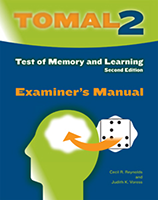Test of Memory and Learning Second Edition (TOMAL-2) is a nationally standardised test for evaluating general and specific memory functions
Test of Memory and Learning | Second Edition
TOMAL-2
Test of Memory and Learning Second Edition (TOMAL-2) is a nationally standardised test for evaluating general and specific memory functionsChoose from our formats
Kits
Starter & complete kits, print & digital
1 option
Test forms & reports
Booklets, record forms, answer sheets, report usages & subscriptions
2 options
All products
All tests and materials offered for TOMAL-2
3 options